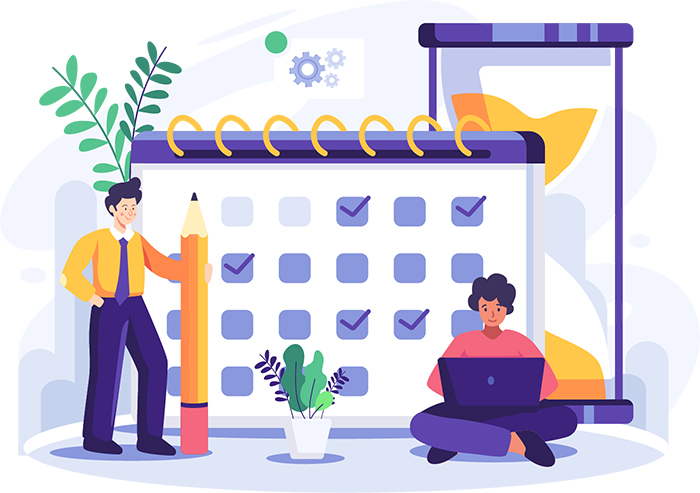How often do you find yourself wishing for more time or commenting that there are not enough hours in a day? While we cannot increase the time in a day, we can help you with some great tips to help you manage your time better and juggle priorities to achieve the most with the time available.
In this blog, we are going to explore various methods and tools you can use to help your time management skills. This will include methods to help set goals and prioritize, or tools to help you manage your to-do list. If you’re struggling with your time management skills, you are not alone! 82% of Americans say they don’t proactively use tools or methodologies to help manage their time.
Why is time management important?
While it may seem obvious that time management is the ability to use time effectively and productively throughout the day, the reasons why it is such an important and desirable skill are often overlooked. Consistently managing our time can significantly reduce stress levels, leading to increased productivity and improved overall mental health.
High-stress levels can cause exhaustion, fatigue, anxiety, and decreased satisfaction in life and work. By improving our time management skills, we can alleviate some of this stress, leading to a more balanced, fulfilling, and productive day.
Create a plan and schedule
Creating a plan and schedule is vital for effective time management, especially for those juggling multiple responsibilities, such as students with various deadlines. Start by making a comprehensive list of tasks and goals you need to accomplish. This step provides a clear picture of what lies ahead and helps you stay organized. In fact, 73% of people claim they find creating a to-do list a calming activity that sets them up for success.
Next, outline specific, achievable goals and prioritize them based on urgency and importance. Breaking down larger tasks into smaller, manageable steps can make even the most daunting projects feel achievable.
A daily schedule helps you focus on immediate tasks, a weekly schedule allows for a broader view of ongoing commitments, and a monthly schedule provides insight into long-term goals. Utilize tools such as calendars, planners, or digital apps.
There are some great tools for every budget. Google Calendar is a great free calendar and Trello offers some helpful features even in the free package. If you do have more of a budget, it’s worth reviewing applications such as Asana or Hive for more powerful solutions.
Including buffer time in your schedule is essential to handle unexpected tasks or delays. By setting clear priorities and maintaining a flexible, structured schedule, you ensure that your most critical tasks receive the attention they need, paving the way for a more productive and balanced day.

Setting Clear Goals and Priorities
Once you have a plan and schedule in place, setting clear goals and priorities becomes essential for effective time management.
One of the most effective ways to establish goals is by using SMART: Specific, Measurable, Achievable, Relevant, and Time-bound. SMART goals provide a clear and structured framework that makes it easier to track progress and achieve desired outcomes. Additionally, prioritizing tasks is crucial to ensure that the most important and urgent tasks are addressed first.
The Eisenhower Matrix and The ABCDE Method are two effective techniques for prioritizing tasks.
The Eisenhower Matrix, also known as the Urgent-Important Matrix, categorizes tasks into four quadrants based on their urgency and importance:
- Urgent and Important: Tasks that require immediate attention and contribute to your long-term goals (e.g., meeting deadlines, handling crises).
- Important but Not Urgent: Tasks that are important for achieving long-term goals but do not require immediate action (e.g., strategic planning, skill development).
- Urgent but Not Important: Tasks that require immediate attention but do not significantly impact long-term goals (e.g., answering non-critical emails, attending some meetings).
- Not Urgent and Not Important: Tasks that have little to no impact on your long-term goals and can often be minimized or eliminated (e.g., trivial activities, excessive social media use).
Using the Eisenhower Matrix means you can focus on high-impact tasks and avoid getting bogged down by less important activities.
The ABCDE method, developed by productivity expert Brian Tracy, helps prioritize tasks by assigning each a letter based on its importance and urgency:
- A: Very important tasks that must be done—serious consequences if not completed.
- B: Important tasks that should be done—moderate consequences if not completed.
- C: Nice-to-do tasks that would be beneficial but have no consequences if not completed.
- D: Delegate tasks that can be assigned to someone else.
- E: Eliminate tasks that are not necessary and do not contribute to your goals.
Then, within each category, you can further prioritize tasks by numbering them (e.g., A1, A2, B1, B2). This method helps ensure that you focus on tasks that have the greatest impact.
Avoiding Procrastination and Staying Focussed
Avoiding procrastination and maintaining focus are essential for effective time management. Procrastination often stems from common causes such as feeling overwhelmed by tasks, fearing failure, or lacking motivation. Overcoming these obstacles requires a combination of self-awareness and practical strategies.
One effective technique is the Pomodoro Technique, which involves working for 25-minute intervals followed by a 5-minute break. This method helps maintain concentration and reduces the likelihood of burnout. There are several other time management techniques such as Time Blocking and Eat the Frog, as well as numerous others. It’s all about finding the method that works best for you.
Maintaining focus can be further enhanced by setting specific work periods and incorporating regular breaks to recharge. Establishing a conducive work environment is crucial as well. Minimize distractions by creating a tidy, organized workspace and limiting access to distracting websites or apps during work periods. Noise-cancelling headphones or background music can help maintain concentration.
Enhancing Efficiency with Technology
Technology offers a huge amount of tools that can help enhance time management practices, improving productivity and organizational efficiency. These can include task tracking tools mentioned earlier for planning scheduling, note taking apps such Obsidian and Joplin help streamline the note-making process. Additionally, the use of AI can help tasks like summarising a meeting or lecture with applications like Fathom. AI can help you save time, by reducing some of the work in completing a task, leaving you more time to focus on the more urgent jobs. There are also collaboration tools to help digital communication between coworkers, which will be discussed further in the next section.
Incorporating technological solutions into daily operations can enhance organizational skills, reduce the risk of overlooking important tasks, and improve effectiveness in educational and corporate environments.
Delegation and Collaboration
Effective time management also involves recognizing tasks that can be delegated to others. Delegating tasks not only frees up your time for more critical activities but also empowers team members and promotes a collaborative work environment. In both educational and enterprise settings, effective delegation requires clear communication, trust, and an understanding of each team member’s strengths and workload.
Here are some tips for effective delegation:
- Identify tasks that can be delegated: Focus on routine or time-consuming tasks that do not require your specific expertise.
- Choose the right person: Delegate tasks to individuals who have the necessary skills and capacity to complete them.
- Provide clear instructions: Ensure that the person understands the task, its importance, and the expected outcome.
- Set deadlines and expectations: Clearly communicate when the task should be completed and any milestones along the way.
- Offer support and resources: Be available to answer questions and provide the tools or resources needed for the task.
- Trust and empower: Allow the person to complete the task without micromanaging, which helps build their confidence and skills.
- Provide feedback: After the task is completed, offer constructive feedback to help them improve and acknowledge their efforts.
Collaboration tools like Slack and Lark play a crucial role in managing time efficiently, especially those with remote or hybrid teams. These platforms facilitate real-time communication, file sharing, and project management, making it easier to coordinate with team members and stay on top of tasks. Features like channels, group chats, and integrations with other productivity apps streamline workflows and reduce the time spent on email and meetings. By leveraging these tools, teams can enhance collaboration, ensure everyone is aligned, and maintain productivity even in remote or hybrid work environments.

Continuous Improvement and Reflection
Regular self-assessment and reflection on time management practices are vital for ongoing improvement and efficiency. Taking the time to evaluate what methods are working well and which ones could be improved allows individuals to adapt their strategies accordingly. Not every tool or methodology is going to work for everyone. By reflecting on past successes and challenges, it idenifies areas to improve whilst celebrating progress.
This self-awareness enables further refining of techniques, experimenting with new methods, and ultimately optimizing productivity. Embracing a mindset of continuous improvement fosters resilience, adaptability, and a commitment to maximizing productivity.
Conclusion
In conclusion, effective time management is a critical skill for anyone and is essential for balancing responsibilities and maximizing productivity. This blog has explored various strategies and tools to help individuals better manage their time and tasks. From creating comprehensive plans and schedules to setting clear goals and priorities using techniques like SMART criteria, Eisenhower Matrix, and ABCDE method. To leveraging technology and AI for enhanced efficiency as well as introducing some time management methods such as The Pomodoro Technique.
By implementing these tips and techniques, individuals can experience increased productivity, reduced stress, and a greater sense of accomplishment in both their academic and professional endeavors. So, whether you’re a student juggling coursework or an employee navigating a demanding workload, prioritizing effective time management can lead to success and well-being. Start implementing these strategies today and reap the benefits of a more organized and productive day.




